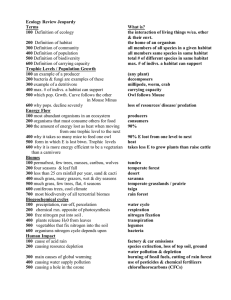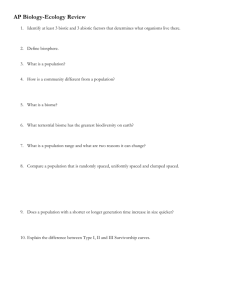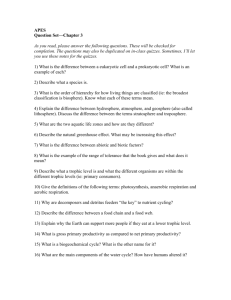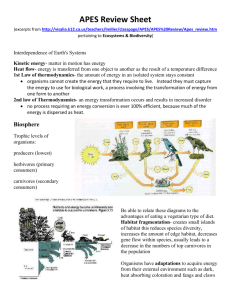Final Exam #4
advertisement
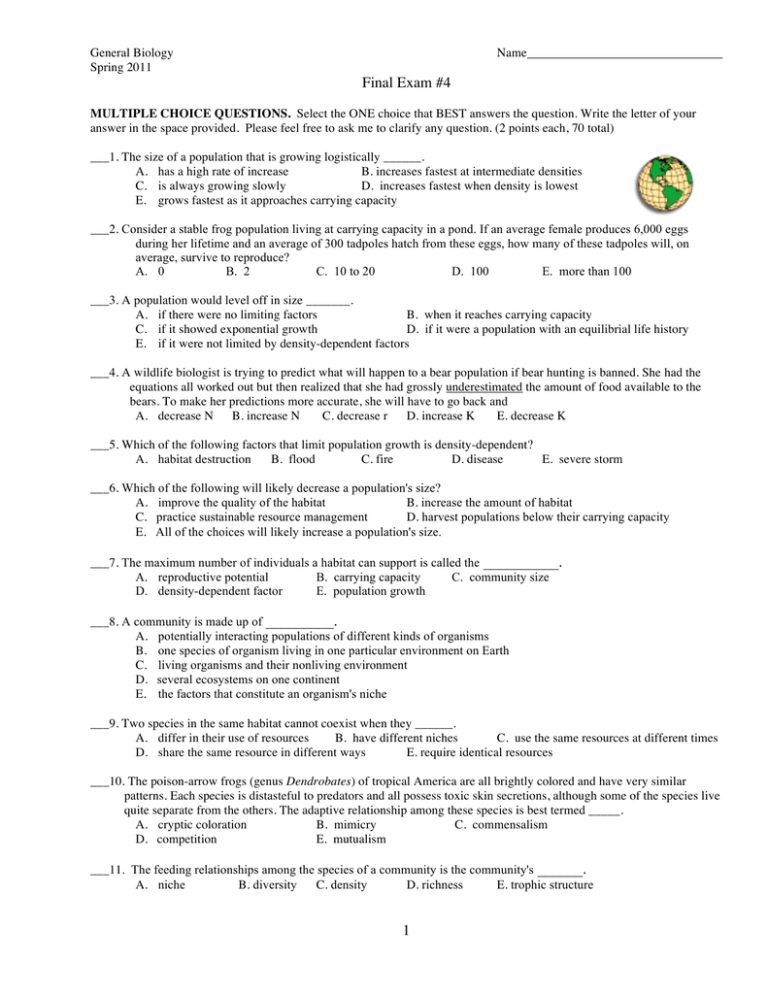
General Biology Spring 2011 Name Final Exam #4 MULTIPLE CHOICE QUESTIONS. Select the ONE choice that BEST answers the question. Write the letter of your answer in the space provided. Please feel free to ask me to clarify any question. (2 points each, 70 total) ___1. The size of a population that is growing logistically ______. A. has a high rate of increase B. increases fastest at intermediate densities C. is always growing slowly D. increases fastest when density is lowest E. grows fastest as it approaches carrying capacity ___2. Consider a stable frog population living at carrying capacity in a pond. If an average female produces 6,000 eggs during her lifetime and an average of 300 tadpoles hatch from these eggs, how many of these tadpoles will, on average, survive to reproduce? A. 0 B. 2 C. 10 to 20 D. 100 E. more than 100 ___3. A population would level off in size _______. A. if there were no limiting factors B. when it reaches carrying capacity C. if it showed exponential growth D. if it were a population with an equilibrial life history E. if it were not limited by density-dependent factors ___4. A wildlife biologist is trying to predict what will happen to a bear population if bear hunting is banned. She had the equations all worked out but then realized that she had grossly underestimated the amount of food available to the bears. To make her predictions more accurate, she will have to go back and A. decrease N B. increase N C. decrease r D. increase K E. decrease K ___5. Which of the following factors that limit population growth is density-dependent? A. habitat destruction B. flood C. fire D. disease E. severe storm ___6. Which of the following will likely decrease a population's size? A. improve the quality of the habitat B. increase the amount of habitat C. practice sustainable resource management D. harvest populations below their carrying capacity E. All of the choices will likely increase a population's size. ___7. The maximum number of individuals a habitat can support is called the __________. A. reproductive potential B. carrying capacity C. community size D. density-dependent factor E. population growth ___8. A community is made up of _________. A. potentially interacting populations of different kinds of organisms B. one species of organism living in one particular environment on Earth C. living organisms and their nonliving environment D. several ecosystems on one continent E. the factors that constitute an organism's niche ___9. Two species in the same habitat cannot coexist when they ______. A. differ in their use of resources B. have different niches C. use the same resources at different times D. share the same resource in different ways E. require identical resources ___10. The poison-arrow frogs (genus Dendrobates) of tropical America are all brightly colored and have very similar patterns. Each species is distasteful to predators and all possess toxic skin secretions, although some of the species live quite separate from the others. The adaptive relationship among these species is best termed _____. A. cryptic coloration B. mimicry C. commensalism D. competition E. mutualism ___11. The feeding relationships among the species of a community is the community's ______. A. niche B. diversity C. density D. richness E. trophic structure 1 ___12. Two species of cuckoo dove live in a group of islands of the coast of New Guinea. Out of the 33 islands, 14 have one species, 6 have the other, 13 have neither and none has both. What might best explain this? The two species of birds could _____. A. be on different trophic levels B. be detritivores C. be keystone predators D. have different niches E. shave similar niches ___13. The differentiation of niches that enables similar species to coexist in a community is called _____. A. resource partitioning B. the competitive exclusion principle C. interspecific competition D. niche competition E. resource reduction ___14. We expect that a keystone species that is a predator will A. harvest prey species down to extinction C. maintain the species diversity in a community E. More than one of the choices is correct. ______. B. help many of its prey reproduce D. be a parasite ___15. Which of the following lists only biotic environmental factors? A. food, temperature, fire, wind B. wind, temperature, soil minerals, light C. light, rainfall, food, temperature D. food, parasites, predators, competitors E. soil minerals, oxygen level, light, predators ___16. Ecosystems are characterized by ________. A. cycling of nutrients B. complex food chains D. biotic and abiotic grazers E. both A and B are correct C. circular energy flow ___17. In a food chain consisting of phytoplankton → zooplankton → fish → fishermen, the phytoplankton are ______. A. primary consumers B. secondary consumers C. producers D. detritivores E. tertiary consumers ___18. The main decomposers in an ecosystem are _______. A. plants and animals B. bacteria and viruses C. bacteria and plants E. fungi and bacteria D. plants and algae ___19. Why is a diagram of energy flow from trophic level to trophic level shaped like a pyramid? A. Organisms at each level store most of the energy and pass little on. B. There are more producers than primary consumers, and so on. C. Organisms eventually die as they get older. D. Most energy at each level is lost, leaving little for the next. E. Secondary consumers are larger than primary consumers, and so on. ___20. You want to do all that you can to help our global environment. One thing you can do every day is to eat a diet that consists of organisms that are _____. A. producers B. primary consumers C. secondary consumers D. tertiary consumers E. a mix of producers and consumers ___21. Which of the following conversions does not represent a step in the nitrogen cycle? A. atmospheric nitrogen to ammonium B. ammonium to nitrites C. nitrites to nitrates D. nitrates to atmospheric nitrogen E. ammonium to atmospheric nitrogen ___22. Why are many of the world's deserts located at latitudes of about 30° north and south? A. The greatest amount of solar energy per unit area is absorbed by Earth at about 30° north and south. B. Warm air rises at about 30° north and south and spreads towards the poles and the equator. C. Dry air, originating at the equator, descends toward Earth's surface at about 30° north and south. D. Earth is tilted on its axis. E. Earth is a rotating sphere. ___23. Which level of ecologic organization incorporates abiotic factors? A. community B. ecosystem C. population D. species E. symbioses ___24. Which of the following would you expect to find in an area of ocean upwelling? A. warm, nutrient rich water B. cold, nutrient poor water C. warm, nutrient poor water D. warm water with average nutrient levels E. cold, nutrient rich water 2 ___25. The tropical forest biome recovers very slowly after it is cleared-- and the land used for farming or mining-- because of its poor soils. What factor(s) contribute to the infertilities of tropical forest soils? A. high temperatures B. high rainfall C. rapid decomposition D. luxuriant growth of living organisms E. all are correct ___26. Bob was reading the newspaper. More people burned out of their homes in Southern California, he remarked. His wife, Barb, looked up from her reading. That’s a shame, she said. But I guess you have to expect a fire once in awhile if you live in the ____________. A. temperate grassland B. tundra C. chaparral D. conferous forest E. savanna ___27. When people speak of the "rain shadow" of the California Coast Range, they are referring to the _______. A. shadow cast by the mist and clouds that hover above the crest of the range B. forested condition of the eastern flank of the range compared to the western flank C. scarcity of rain on the eastern flank and adjacent lowlands compared to the western flank D. dark-colored chaparral vegetation that grows on the eastern flank E. fact that the vegetation of the eastern flank stays green further into the summer than the vegetation of the western flank or adjacent lowlands ___28. Which one of the following is characteristic of the chaparral biome? A. Sparse, thin shrubs with fleshy deciduous leaves. B. Vegetation adapted to high altitude. C. Low amounts of rainfall at unpredictable periods throughout the year. D. Many plants with seeds that need fire to germinate. E. Animals that include bear, fruit-eating bats, lemurs, frogs, and salamanders. ___29. Which of the following poses the single greatest threat to biodiversity? A. Native species. B. Overfishing. C. Movement corridors. D. Habitat loss. E. Ozone hole. ___30. Which of the following is characteristic of endemic species? A. They are often found in biodiversity hot spots. B. They are distributed widely in the biosphere. C. They require edges between ecosystems. D. Their trophic position makes them very susceptible to biological magnification. E. They are often keystone species whose presence helps to structure a community. ___31. The primary cause of extinction of native species of fish in Lake Victoria is _______. A. a decrease in the size of the lake due to use of water in irrigation B. fragmentation C. recreational use D. the introduction of an alien species E. PVA ___32. Biodiversity hot spots are ________. A. regions where there is the potential for high levels of extinction B. regions where thermophilic species thrive C. C. the same for all groups of organisms D. relatively resistant to environmental degradation due to their large number of species E. distributed evenly throughout the biosphere. ___33. Some biologists think that half of all species on the Earth may be exterminated in the next century. Mass extinctions have happened before. How would this one be different? A. This time species are threatened by climate change B. This extinction is happening at a much faster rate. D. A much larger fraction of earth's species are likely to be affected. E. All life on earth may eventually be extinguished. E. This extinction is much more gradual and difficult to notice. ___34. Ospreys and other top predators are most severely affected by pesticides such as DDT because they ______. A. are especially sensitive to chemicals B. have rapid reproductive rates C. have very long life spans D. store the pesticides in their tissues E. consume prey in which pesticides are concentrated 3 ___35. With limited resources, conservation biologists need to prioritize their efforts. Of the following choices, which should receive the greatest attention for the goal of conserving biodiversity? A. The northern spotted owl B. A commercially important species C. Threatened and endangered vertebrate species D. All endangered species E. A declining keystone species in a community TRUE/FALSE. Write T for TRUE statements and F for FALSE statements in the space provided. (2 points each, 30 total) ___36. Population ecology addresses changes in population size and the factors that regulate populations over time. ___37. When birth rate equals death rate, and immigration equals emigration, population size remains constant. ___38. Countries do not vary significantly in their available ecological footprint. ___39. The niche of an organism is its trophic position in the food chain. ___40. Resource partitioning allows populations with similar niches to live together in the same habitat. ___41. The yellow and black patterns on a bee and on a hornet are an example of mimicry. ___42. In the global nitrogen cycle, nitrogen flows from plants to animals in the form of organic compounds. ___43. Energy loss from an ecosystem occurs in the form of heat. ___44. The nitrogen cycle requires a special kind of eukaryotic protist to convert nitrogen gas into usable nitrogen for plants. ___45. The biosphere is self-contained except for sunlight energy and heat. ___46. Climate, the long-term variation in temperature and rainfall, influences the distribution of life on Earth. ___47. The major factor in tropical deforestation is governments of developing countries selling off land to earn cash. ___48. National parks are the only kind of protected area. ___49. Biodiversity hot spots are relatively resistant to environmental degradation due to their large number of species. ___50. Restoration ecology is the science of facilitating the return of a degraded ecosystem to a more natural condition. HAVE A GREAT SUMMER AND BEST WISHES FOR YOUR CONTINUED ACADEMIC SUCCESS!! 4



